Looking to express the deep bond and love you have for your family through body art? Japanese tattoos offer a meaningful and visually striking way to honor your loved ones.
With a rich cultural history and symbolism, Japanese tattoos have evolved beyond their association with the yakuza and are now embraced by people from all walks of life. The Japanese symbol for family holds profound meaning, making it a popular choice for tattoo designs. Whether you prefer an intricate design or simple script, there are countless examples that beautifully capture the essence of family.
So if you’re ready to embark on a journey of self-expression that pays homage to your loved ones, buckle up as we dive into the captivating world of family-inspired Japanese tattoos.
Contents
- 1 Significance of the Japanese Symbol for Family
- 2 The Kanji Character and Its Relation to Family Bonds
- 3 Variations of “Family” in Japanese Tattoo Culture
- 4 Popularity and Adoption of Family Kanji in Tattoos
- 5 Comparing Chinese and Japanese Characters for “Family”
- 6 “Family First” and Yojijukugo in Japanese Tattoos
- 7 Artistic Interpretations of Family in Japanese Tattoos
- 8 Choosing the Right Format for Your Tattoo Design
- 9 Practical Considerations Before Inking Family Kanji
- 10 Conclusion
- 11 Frequently Asked Questions
- 11.1 FAQ
- 11.2 What is the significance of the Japanese symbol for family in tattoos?
- 11.3 How does the “Family First” concept relate to Japanese tattoos?
- 11.4 Are there different variations of the word “family” in Japanese tattoo culture?
- 11.5 How does the Chinese character for “family” differ from its Japanese counterpart?
- 11.6 What should I consider before getting a family kanji tattoo?
Significance of the Japanese Symbol for Family
Representation of “家” (ie)
The Japanese symbol for family is represented by the kanji character “家” (ie). This character holds deep cultural significance and represents more than just the word “family.” It embodies the concept of home, lineage, and familial bonds that are highly valued in Japanese society.
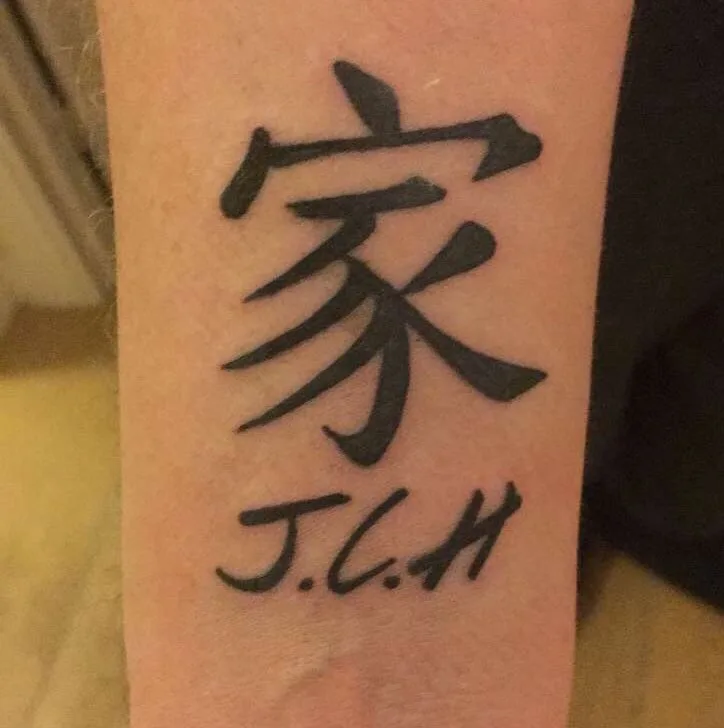
Concept of Home and Belonging
The symbol “家” (ie) carries a sense of unity and belonging. In Japanese culture, the concept of home extends beyond physical space; it encompasses emotional connections and a feeling of security within one’s family. The kanji character captures this essence, reminding individuals of their roots and providing a sense of comfort and stability.
Lineage and Ancestral Connections
The symbol for family also represents lineage and ancestral connections. It serves as a reminder of one’s heritage, connecting individuals to their ancestors who have come before them. This connection to past generations fosters a deep appreciation for family history and traditions.
Unity, Respect, and Loyalty
The Japanese symbol for family emphasizes unity, respect, and loyalty towards one’s kin. Within the context of this symbol, unity refers to the strong bond shared among family members. It highlights the importance of supporting each other through both joyous occasions and challenging times.
Respect plays a crucial role in Japanese culture, especially within families. The symbol reminds individuals to honor their parents, grandparents, and other elders who have played significant roles in shaping their lives.
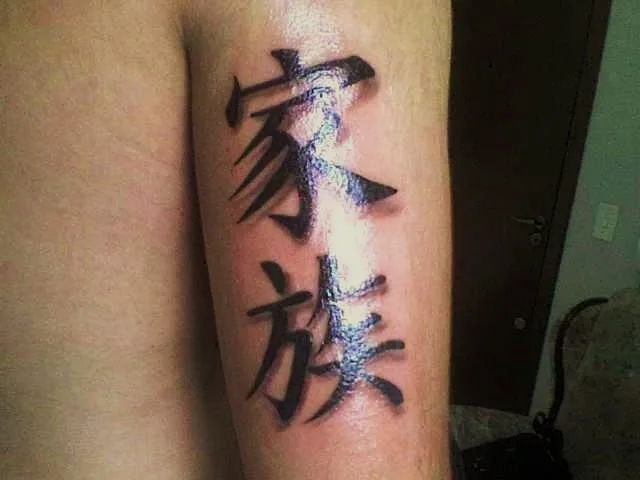
Loyalty is another core value represented by this symbol. It signifies unwavering commitment to one’s family members through thick and thin. Loyalty is deeply ingrained in Japanese culture as an essential virtue within familial relationships.
Symbolic Representation in Tattoos
Many people choose to incorporate the Japanese symbol for family into tattoo designs as a way to honor their own familial bonds or express gratitude towards their loved ones. These tattoos serve as a permanent reminder of the importance of family and the values associated with it.
The symbol can be tattooed alone or combined with other elements such as flowers, animals, or names to personalize the design further. Each person’s interpretation and choice of accompanying elements may vary, making each family tattoo unique and meaningful.
Cultural Appreciation and Connection
Adopting the Japanese symbol for family in tattoos is not limited to individuals of Japanese descent. People from various cultural backgrounds appreciate its significance and choose to incorporate it into their body art as a way to connect with the rich history and values associated with Japanese culture.
By embracing this symbol, individuals showcase their respect for diverse cultures and celebrate the universal importance of family bonds. It serves as a visual representation of love, unity, and gratitude towards one’s relatives, regardless of cultural background.
The Kanji Character and Its Relation to Family Bonds
The Significance of the Kanji Character “家”
The kanji character for family in Japanese is written as “家” (pronounced as “ka” or “ie”). This character consists of two parts: “宀” (mune), which means roof or house, and “豕” (shi), which represents a pig or boar.
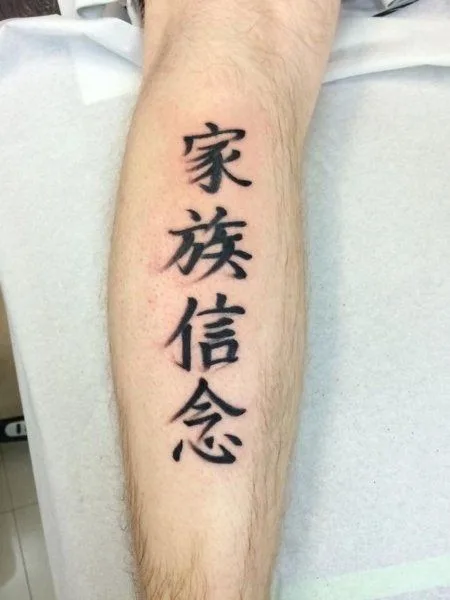
Shelter and Sustenance
The combination of these two elements in the kanji character signifies the importance of shelter and sustenance provided by the family. The concept of a roof over one’s head symbolizes protection, security, and a sense of belonging. It represents the idea that the family unit serves as a safe haven where individuals can find comfort, support, and love.
Generations Living Under One Roof
Furthermore, the kanji character for family also reflects the traditional Japanese value of generations living together under one roof. In Japan, it is common for multiple generations to reside in the same household, fostering strong family ties and close-knit relationships. This arrangement allows for mutual care and support among family members, creating a sense of unity that extends beyond immediate relatives.
Emphasizing Strong Family Bonds
The kanji character “家” emphasizes the significance of strong family bonds within Japanese culture. It serves as a reminder that families are not only connected by blood but also by shared experiences, traditions, values, and responsibilities. The character encapsulates the idea that being part of a family means being there for one another through thick and thin.
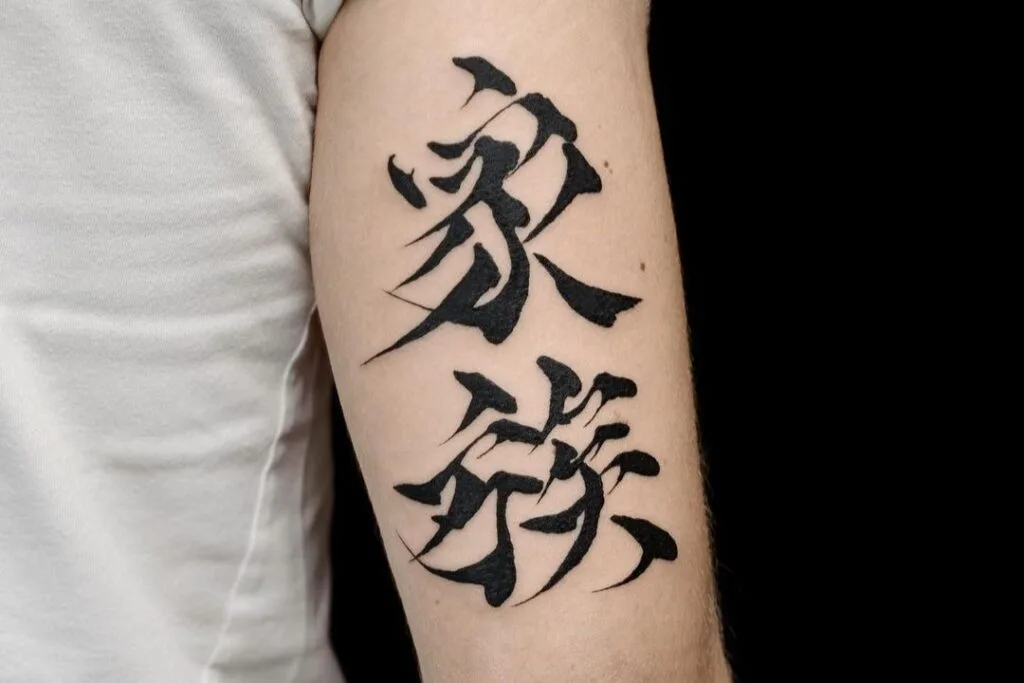
Symbolic Representation
In addition to its linguistic meaning, this kanji symbol holds deep symbolic representation in various contexts related to family bonds. It is commonly used in tattoos to visually represent one’s commitment to their familial relationships. People often choose to incorporate this symbol into their body art as a way to honor their heritage or express their love and devotion to their family.
A Timeless Reminder
A tattoo featuring the kanji character for family serves as a timeless reminder of the importance of familial connections. It can be a source of inspiration during challenging times, reminding individuals of the support system they have in their loved ones. This symbol can also serve as a tribute to ancestors and a way to preserve cultural heritage.
Variations of “Family” in Japanese Tattoo Culture
Artistic Interpretations of the Kanji Character for Family
In Japanese tattoo culture, the kanji character for family holds significant meaning and is often incorporated into various artistic interpretations. This character, 家族 (kazoku), represents the concept of family and carries a deep sense of connection, love, and unity.
Tattoo artists have found creative ways to bring this symbolism to life through their designs. They skillfully blend traditional elements with modern techniques to create unique and visually stunning tattoos that honor the importance of family bonds.

Incorporating Additional Elements to Enhance Symbolism
Some Japanese family tattoos go beyond just the kanji character itself. Tattoo artists often incorporate additional elements such as cherry blossoms or dragons to enhance the symbolism and add depth to the design.
Cherry blossoms, known as sakura in Japanese culture, represent beauty, transience, and renewal. By including these delicate flowers in a family tattoo design, it signifies the fleeting nature of life and reminds us to cherish our loved ones while we can.
Dragons are another popular element used in Japanese tattoos. These mythical creatures symbolize strength, wisdom, and protection. When combined with the kanji for family, it conveys a powerful message about safeguarding one’s loved ones and nurturing strong familial ties.
By incorporating these additional elements into family tattoos, individuals can personalize their designs further and infuse them with deeper meanings that resonate with their own experiences.
Different Styles for Unique Family Tattoo Designs
Japanese tattoo culture offers a wide range of styles that can be used to create unique family tattoo designs. Traditional irezumi is one such style that has been practiced for centuries in Japan. It involves intricate hand-poked techniques using bamboo needles and natural ink pigments derived from plants.
Irezumi tattoos often feature bold lines, vibrant colors, and elaborate motifs inspired by traditional Japanese art, folklore, and mythology. The use of this style in family tattoos can create visually striking designs that pay homage to Japanese heritage and cultural traditions.
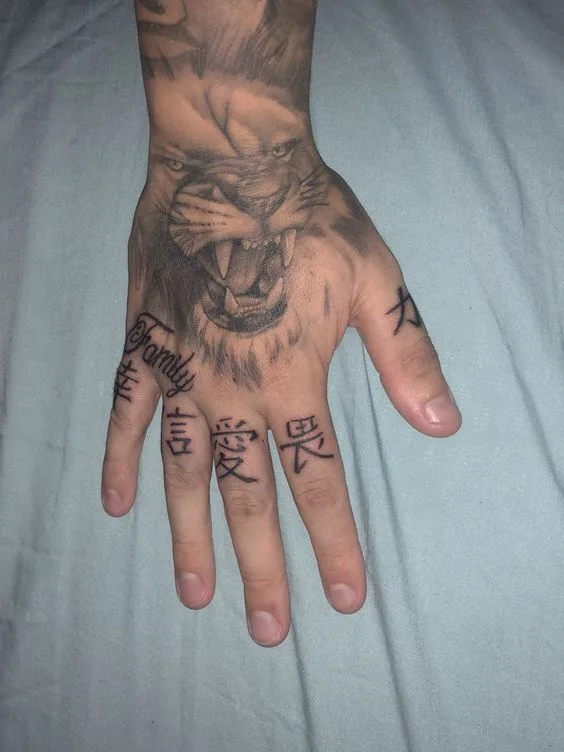
On the other hand, modern blackwork is a contemporary style that focuses on bold black ink designs. It often incorporates geometric patterns, abstract shapes, and negative space to create visually impactful tattoos.
For those seeking a more minimalist approach to their family tattoo, blackwork can be an excellent choice. Its simplicity allows for clean lines and stark contrasts, resulting in a design that is both visually appealing and meaningful.
Whether one chooses the traditional irezumi style or opts for modern blackwork, the variations of family tattoos in Japanese culture offer endless possibilities for individuals to express their love and appreciation for their families in unique and artistic ways.
Popularity and Adoption of Family Kanji in Tattoos
Growing Popularity of Family Kanji Tattoos
Family kanji tattoos have become increasingly popular in recent years. Many people are drawn to this design as a way to honor their heritage or express their love for their family. The appeal lies in the simplicity and elegance of the Japanese characters, which add a unique and meaningful touch to the tattoo.
Honoring Heritage and Expressing Love
For individuals with Japanese roots, getting a family kanji tattoo is a way to pay homage to their ancestry. It serves as a visual representation of their cultural identity and can be seen as a tribute to their family’s history and traditions. By permanently etching these characters onto their skin, they carry a reminder of their heritage wherever they go.
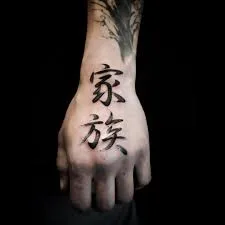
Moreover, family kanji tattoos are also chosen by those who want to celebrate the importance of family bonds. The design symbolizes unity, love, and support among family members. It serves as a constant reminder of the unconditional love that exists within one’s family circle.
Influence of Celebrities and Influencers
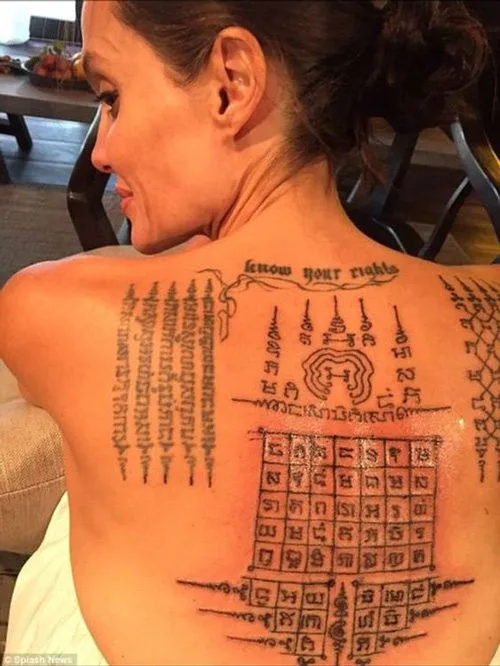
The popularity of family kanji tattoos has been further fueled by celebrities and influencers showcasing their own designs. When well-known figures proudly display these tattoos, it catches the attention of fans and followers who may be inspired to get one themselves.
Celebrities like Angelina Jolie, David Beckham, and Rihanna have all sported kanji tattoos that represent various aspects of their lives, including family. Their influence extends beyond just fashion trends; it also impacts the world of body art. As fans admire these public figures’ tattoos on social media or in magazines, they may feel inspired to explore similar designs for themselves.

Cultural Appreciation through Body Art
The adoption of family kanji tattoos by individuals from different cultural backgrounds highlights the universal value placed on familial relationships. People from diverse backgrounds find resonance in the idea that family is an essential part of their lives, regardless of cultural or geographical differences.
This cross-cultural appreciation is a beautiful testament to the power and significance of family in human existence. It serves as a reminder that love and connection transcend language barriers and cultural boundaries.
Personal Expression and Individual Meaning
While family kanji tattoos have gained popularity, it’s important to note that each person’s tattoo carries unique personal meaning. The design may represent different aspects of their family, such as specific family members’ names or symbols that hold sentimental value.
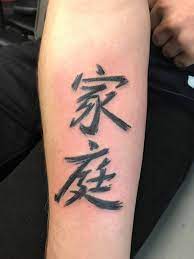
For some individuals, the tattoo may symbolize strength and resilience, reminding them of the support they receive from their loved ones during difficult times. Others may choose to include additional elements like flowers or animals to further personalize the design and reflect their individuality.
Comparing Chinese and Japanese Characters for “Family”
Differences in Representation
While both Chinese and Japanese languages use characters derived from ancient Chinese script, there are differences in how they represent the concept of “family.” In Chinese, the character for family is “家” (jiā), which carries a similar meaning to the Japanese kanji. However, there are variations in stroke order and pronunciation between the two languages.
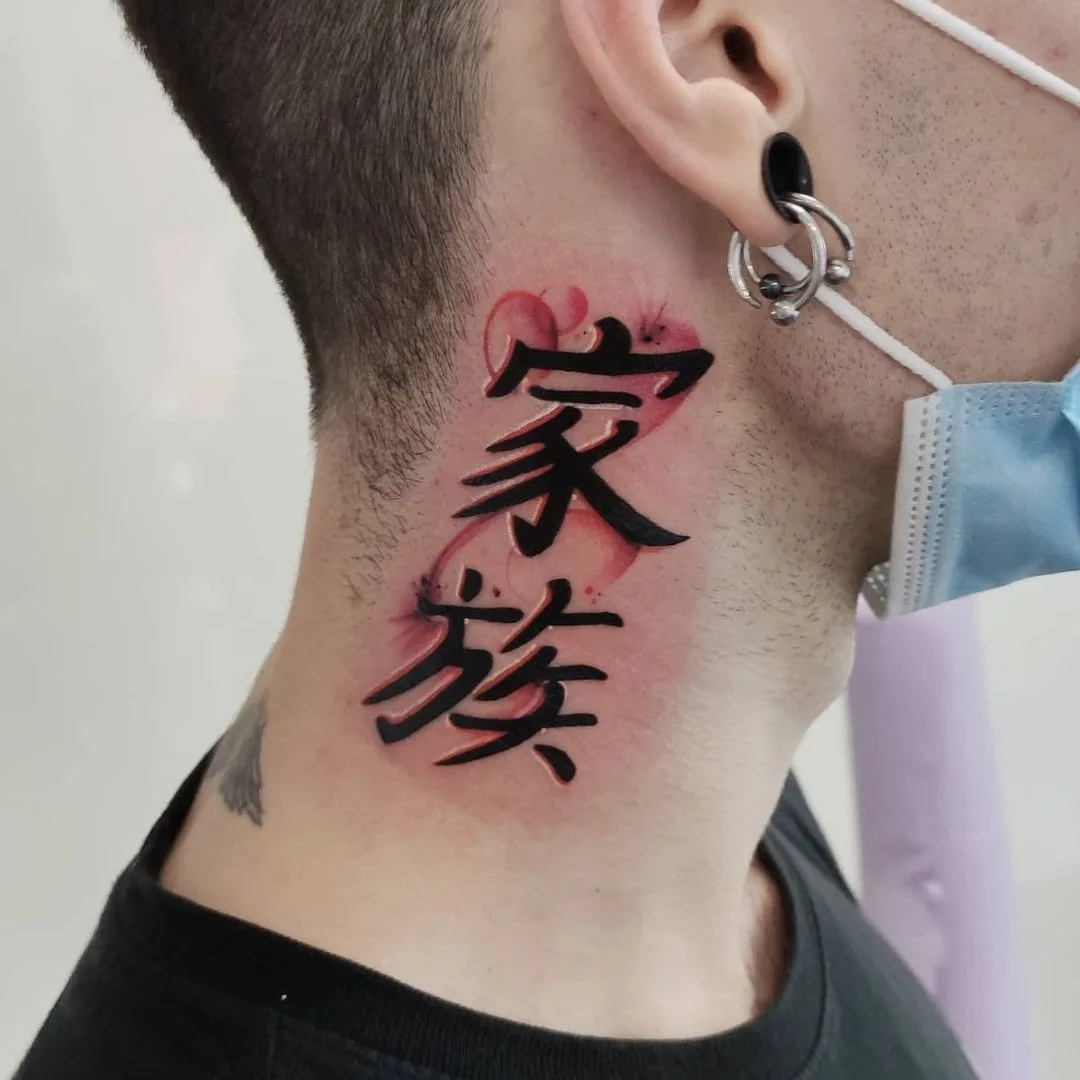
In Chinese calligraphy, the character “家” consists of three parts: a roof on top, followed by a pig underneath it, and finally a person inside the house. This composition symbolizes the idea of a family living under one roof. On the other hand, in Japanese calligraphy, the kanji for family is written as “家族” (kazoku). It combines two characters: “家” (ie) meaning house or home, and “族” (zoku) meaning tribe or clan. Together, they convey the notion of a group of people connected by blood or marriage.
Stroke Order Variations
One notable difference between Chinese and Japanese characters lies in their stroke order. Stroke order refers to the specific sequence in which strokes are written when forming each character. While both languages have guidelines for stroke order to ensure proper balance and aesthetics, there can be variations based on regional customs or personal preferences.
For example, when writing the character for family (“家”), native Mandarin speakers typically start with an upward stroke to form the roof before moving on to draw the pig and person components. In contrast, Japanese calligraphers often begin with a vertical downward stroke for the left side of “家,” followed by drawing horizontal lines to complete its structure.
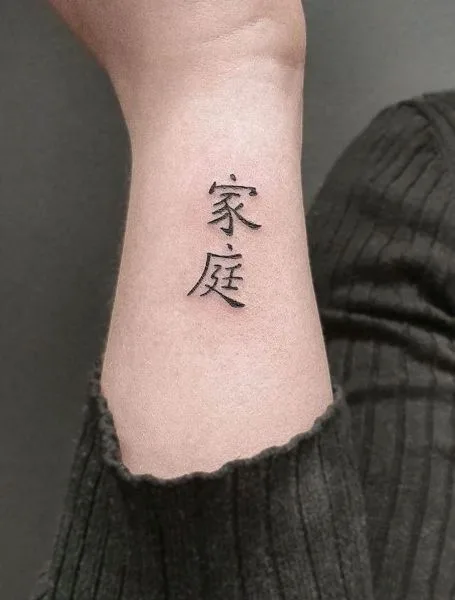
These slight variations in stroke order highlight cultural nuances between China and Japan while still maintaining overall similarities in character representation.
Pronunciation Differences
Another aspect that sets Chinese and Japanese apart is pronunciation. Although both languages share some common characters due to historical and cultural influences, the pronunciation of these characters can differ significantly.
In Chinese, the character for family (“家”) is pronounced as “jiā,” with a rising tone. On the other hand, in Japanese, the pronunciation of “家” varies depending on its usage. It can be read as “ie” when referring to a single household or “kazoku” when describing a broader sense of family encompassing relatives or lineage.
These differences in pronunciation reflect the distinct phonetic systems of Chinese and Japanese and contribute to the unique sound and rhythm of each language.
Cultural Significance
Both Chinese and Japanese cultures place great importance on family values. The concept of family represents a strong bond between individuals and serves as a foundation for social harmony and support.
In China, filial piety (孝顺 xiào shùn) is highly valued, emphasizing respect, obedience, and care towards one’s parents. The character for filial piety (“孝”) is often associated with family values and serves as a reminder of the deep-rooted reverence for ancestors.
Similarly, in Japan, familial relationships are highly cherished. The idea of “ie” (家) extends beyond immediate family members to include extended relatives and ancestors. This notion reflects the traditional emphasis on maintaining harmony within larger kinship networks.
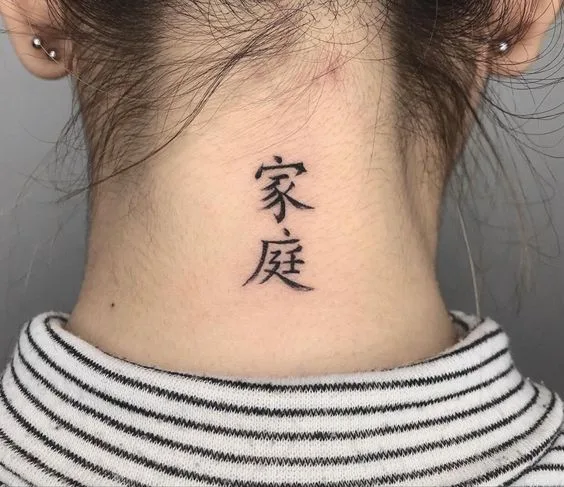
The representation of “family” in both Chinese and Japanese characters underscores the shared cultural significance placed on familial bonds while showcasing subtle distinctions that reflect each language’s unique history and linguistic characteristics.
“Family First” and Yojijukugo in Japanese Tattoos
Yojijukugo, which are four-character idiomatic expressions in the Japanese language, hold significant cultural and artistic value. These expressions have been used for centuries to convey deep meanings and encapsulate complex ideas in a concise manner. In the realm of tattoos, yojijukugo have gained popularity as powerful symbols that represent various aspects of life, including the importance of family values.
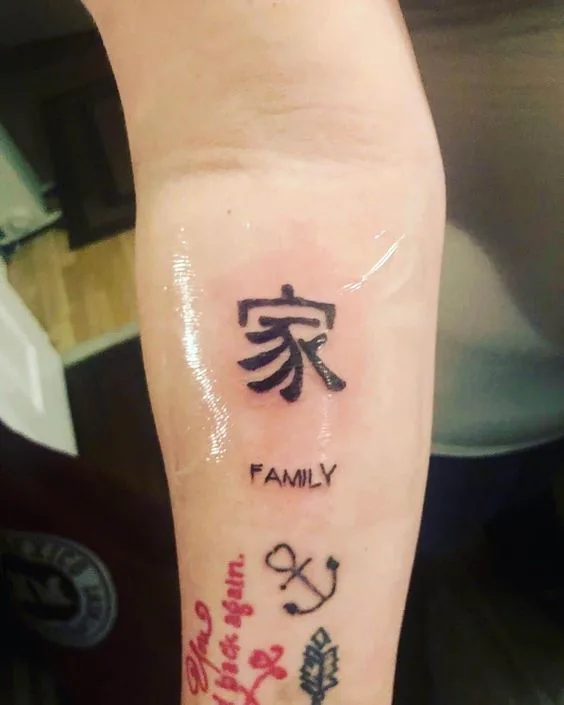
One particular yojijukugo that resonates strongly with many individuals is “家族第一” (kazoku daiichi), which translates to “family first.” This expression serves as a reminder to prioritize our loved ones above all else and emphasizes the significance of familial bonds. It encapsulates the idea that family should always come first in our lives, reminding us to cherish and protect those closest to us.
For many people, getting a tattoo featuring the phrase “家族第一” serves as a constant visual reminder of their commitment to their family. It symbolizes their dedication to nurturing strong relationships with their loved ones and placing them at the forefront of their priorities. This tattoo can act as a source of inspiration during challenging times, reminding individuals of the unwavering support they receive from their family members.
The choice to incorporate yojijukugo like “家族第一” into tattoos also reflects an appreciation for Japanese culture and its rich linguistic heritage. By adorning their bodies with these expressions, individuals pay homage not only to their own families but also to the broader concept of family values within Japanese society. It demonstrates an understanding and respect for cultural traditions while embracing them in a personal and meaningful way.
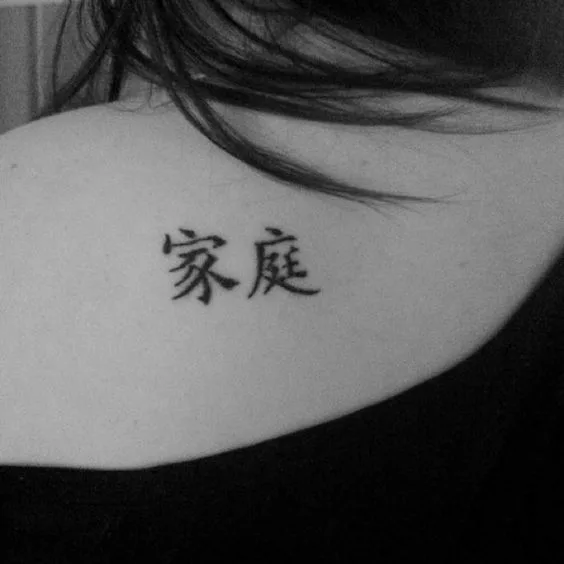
Moreover, yojijukugo tattoos allow individuals to express themselves artistically while conveying profound messages. The characters themselves possess aesthetic beauty through their elegant strokes and balanced composition. When combined with skillful tattoo artistry, these characters become visually captivating and serve as a unique form of self-expression.
The enduring popularity of “家族第一” and other yojijukugo tattoos can be attributed to their ability to convey complex emotions and ideas in a succinct manner. In a world where communication is often dominated by brevity, these expressions provide an opportunity for individuals to reflect on the importance of family values and express them through their body art.
Artistic Interpretations of Family in Japanese Tattoos
Incorporating Unique Artistic Style
Japanese tattoo artists are known for their exceptional skill and creativity.These artists often incorporate their unique artistic style to create meaningful and visually stunning designs. They go beyond simply representing the concept of family and delve into the intricate details that make each design special.
Traditional Motifs Symbolizing Family Bonds
In Japanese tattoo art, traditional motifs are frequently used to represent different aspects of family bonds. One popular motif is the koi fish, which symbolizes strength, determination, and perseverance. The koi fish’s ability to swim against strong currents is seen as a metaphor for overcoming challenges together as a family. Another commonly used motif is the cherry blossom, which represents the transient nature of life and serves as a reminder to cherish moments spent with loved ones.
Samurai imagery can be incorporated into family tattoos to symbolize loyalty, honor, and protection. The samurai’s commitment to their code of conduct reflects the values that many families hold dear. By incorporating these traditional motifs into family tattoo designs, Japanese artists infuse deeper meaning into each piece while paying homage to their cultural heritage.
Enhancing Depth and Visual Appeal
Japanese tattoo artists excel at using color, shading, and composition techniques to add depth and visual appeal to their designs. Through careful consideration of color palettes, they create vibrant tattoos that catch the eye and evoke emotion. For example, warm colors like reds and oranges may be used to convey passion or love within a familial context.
Shading techniques such as hatching or stippling can be employed to add texture and dimensionality to the artwork. This attention to detail brings the design to life on the skin and enhances its overall impact. Furthermore, thoughtful composition ensures that each element within the tattoo harmoniously interacts with one another.
By utilizing these artistic techniques, Japanese tattoo artists elevate family tattoos from mere symbols to works of art that captivate and inspire. The combination of their technical skill and creative vision results in tattoos that not only represent the concept of family but also serve as powerful visual expressions of love, strength, and unity.
Personalization and Individuality
One of the most remarkable aspects of Japanese tattoo art is its ability to be personalized and tailored to each individual’s unique story.This personalization takes on a special significance. Japanese tattoo artists work closely with their clients to understand their personal experiences, values, and relationships within their families.
This collaborative process allows for the creation of custom designs that incorporate meaningful symbols or imagery specific to each person’s family dynamic. Whether it’s a representation of a shared hobby, a beloved pet, or even a significant location, these personalized elements add layers of depth and emotional connection to the tattoo.
By infusing these personal touches into the design, Japanese tattoo artists ensure that each family tattoo becomes a deeply personal and cherished piece of artwork. It serves as a constant reminder of the bond shared with loved ones and can provide comfort during challenging times.
Choosing the Right Format for Your Tattoo Design
Consider Placement and Size
It’s important to consider the placement and size of the design. You want to ensure that the tattoo fits well on your body and complements your overall aesthetic. Whether you choose to have the tattoo on your arm, back, chest, or any other part of your body, take into account factors such as visibility and how it will interact with other tattoos you may have. For example, if you already have a large tattoo on your arm, you may want to opt for a smaller family kanji design in order to maintain balance.
Discuss Ideas with a Skilled Tattoo Artist
To bring your family kanji tattoo design to life, it’s crucial to collaborate with an experienced tattoo artist who specializes in Japanese-style tattoos. They can provide valuable insights and suggestions based on their expertise in this particular art form. By discussing your ideas with them, they can help refine your concept and create a design that truly represents what family means to you. A skilled tattoo artist will also be able to guide you through the process of selecting the right style of kanji characters for your design.
Take Cultural Sensitivities into Account
When selecting the format for your family kanji tattoo design, it’s essential to be mindful of cultural sensitivities and personal preferences. Japanese culture holds great significance. It is important not only to respect these cultural traditions but also ensure that the chosen symbols accurately represent what family means to you personally. Consulting with a knowledgeable tattoo artist who understands these cultural nuances can help ensure that your design is both aesthetically pleasing and culturally appropriate.
Explore Different Tattoo Styles
Japanese tattoos are known for their distinct artistic style and symbolism. When choosing a format for your family kanji tattoo, consider exploring different styles within Japanese tattoo artistry. Traditional Japanese tattoos, known as irezumi, often feature bold lines and vibrant colors. These tattoos typically tell a story or depict mythical creatures such as dragons or koi fish. On the other hand, contemporary Japanese tattoo styles may incorporate elements of realism or minimalism while still maintaining the essence of traditional Japanese design.
Incorporate Kanji Characters into the Design
One way to represent family in your tattoo design is by incorporating kanji characters. Kanji is a system of writing that originated from Chinese characters and has been adopted into the Japanese language. Each character holds its own meaning, making it an ideal choice for expressing familial bonds. You can choose to have individual kanji characters representing each member of your family or combine them to create a larger symbol that represents your entire family unit.
Consider Using Stencils
Using stencils can be a helpful tool when designing your family kanji tattoo. Stencils allow you to visualize how the final design will look on your body before committing to the actual tattooing process. Your tattoo artist can create a custom stencil based on your chosen format and placement, allowing you to make any necessary adjustments before permanently applying the ink. This ensures that you are satisfied with every aspect of your family kanji tattoo design and helps avoid any potential regrets in the future.
Practical Considerations Before Inking Family Kanji
Research Reputable Tattoo Studios
Before getting a family kanji tattoo, it is crucial to research reputable tattoo studios that prioritize hygiene and safety practices. Look for studios with experienced artists who specialize in Japanese tattoos and have a portfolio showcasing their skills in this specific style. Reading online reviews and asking for recommendations from friends or family members who have gotten tattoos can also help you find a trustworthy studio.
Understand the Meaning and Symbolism
When choosing a family kanji design, it is essential to have a clear understanding of its meaning and symbolism. Each kanji character carries its own significance, so take the time to research and ensure that the characters you choose accurately represent your intended message. For example, the kanji for “family” (家族) symbolizes unity, love, and support. However, other kanji characters may convey different meanings related to family dynamics or relationships.
Consider Career Implications
While tattoos are becoming more accepted in society, it is still important to consider potential career implications or social perceptions associated with visible tattoos. Some professions may have strict dress code policies that prohibit visible tattoos or require them to be covered during work hours. Take into account your current job or future career aspirations before deciding on the placement of your family kanji tattoo.
If you work in an industry where visible tattoos are not an issue, such as creative fields or certain service industries, you may have more flexibility in choosing where to ink your tattoo. However, if you work in a conservative profession like law or finance, it may be wise to select a location on your body that can be easily covered by clothing when necessary.
Remember that societal attitudes towards tattoos can vary depending on cultural norms and geographical locations as well. While some countries embrace body art openly, others may still hold negative stereotypes about individuals with visible tattoos. Understanding these cultural nuances can help inform your decision-making process.
Embrace Personal Expression
Ultimately, getting a family kanji tattoo is a personal choice that allows you to express your connection and love for your family. It is an opportunity to celebrate the values and bonds that hold your family together. By carefully considering the practical aspects mentioned above, you can ensure that your tattoo aligns with your personal and professional goals while still honoring the significance of family in Japanese culture.
Remember that tattoos are permanent, so it is crucial to take the time to think about your decision thoroughly. Consider consulting with a tattoo artist who specializes in Japanese designs and can provide guidance based on their expertise. They can help you create a unique and meaningful design that incorporates elements of traditional Japanese artistry while reflecting your personal connection to your family.
By following these practical considerations, you can make an informed decision when choosing a family kanji tattoo. Take the time to research reputable studios, understand the meaning behind your chosen design, consider career implications, and embrace personal expression. In doing so, you will be able to honor both the cultural significance of family in Japanese tattoos and create a lasting tribute to your loved ones.
Conclusion
You’ve now explored the significance of the Japanese symbol for family and its various interpretations in tattoo culture. From the deep-rooted meaning of the kanji character to the artistic expressions that bring it to life, you’ve gained insight into the beauty and power behind family-themed Japanese tattoos.
As you consider getting a family kanji tattoo, remember to choose a design that resonates with your personal connection to family bonds. Take into account practical considerations such as size, placement, and finding a skilled artist who can bring your vision to reality. And most importantly, let your tattoo be a constant reminder of the love, support, and strength that your family brings into your life.
Embrace the significance of family and carry it with you as you navigate through life’s journey. Cherish the memories, celebrate the moments, and always prioritize the bonds that tie you together. Your family tattoo will forever serve as a testament to the importance of love and connection in your life.
Frequently Asked Questions
FAQ
What is the significance of the Japanese symbol for family in tattoos?
The Japanese symbol for family holds deep meaning, representing the importance of familial bonds and unity. It serves as a reminder of one’s roots, love for family, and commitment to their well-being. Incorporating this symbol in tattoos celebrates the strength and support found within families.
How does the “Family First” concept relate to Japanese tattoos?
The concept of “Family First” resonates strongly in Japanese tattoo culture. It emphasizes prioritizing family above all else, showcasing devotion and loyalty. By incorporating this principle into tattoos, individuals express their unwavering dedication to their loved ones.
Are there different variations of the word “family” in Japanese tattoo culture?
Yes, there are various ways to represent “family” in Japanese tattoo designs. Apart from using kanji characters, hiragana or katakana scripts can also be employed creatively. These variations allow for personalization and artistic expression while maintaining the essence of familial connections.
How does the Chinese character for “family” differ from its Japanese counterpart?
While both Chinese and Japanese languages share similar characters, there are slight differences between their respective characters for “family.” The Chinese character emphasizes lineage or ancestry (家), while the Japanese character signifies household or home (家族). However, both convey the concept of family and hold significant cultural importance.
What should I consider before getting a family kanji tattoo?
Before getting a family kanji tattoo, it’s essential to carefully consider factors such as placement, size, font style, and overall design. Researching reputable tattoo artists with experience in Asian script tattoos ensures accurate representation and proper execution of your chosen design.